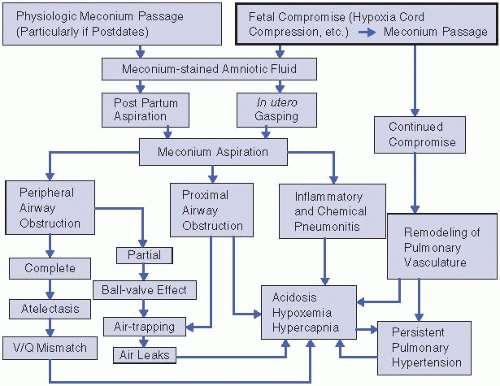Meconium Aspiration
Heather H. Burris
I. BACKGROUND
Cause. Acute or chronic hypoxia and/or infection can result in the passage of meconium in utero. In this setting, gasping by the fetus or newly born infant can cause aspiration of amniotic fluid contaminated by meconium. Meconium aspiration before or during birth can obstruct airways, interfere with gas exchange, and cause severe respiratory distress (Fig. 35.1).
Incidence. Meconium-stained amniotic fluid (MSAF) complicates delivery in approximately 8% to 25% of live births. The incidence of MSAF in preterm infants is very low. Most babies with MSAF are 37 weeks or older, and many meconiumstained infants are postmature and small for gestational age. Approximately 5% of neonates born through MSAF develop meconium aspiration syndrome (MAS) and approximately 50% of these infants require mechanical ventilation.
II. PATHOPHYSIOLOGY.
Meconium is a sterile, thick, black-green, odorless material that results from the accumulation of debris in the fetal intestine during the third month of gestation. The components of meconium include water (72%—80%), desquamated cells from the intestine and skin, gastrointestinal mucin, lanugo hair, fatty material from the vernix caseosa, amniotic fluid, intestinal secretions, bloodgroup—specific glycoproteins, bile, and drug metabolites.
Passage of meconium in utero. MSAF may result from a postterm fetus with rising motilin levels and normal gastrointestinal function, vagal stimulation produced by cord or head compression, or in utero fetal stress. Amniotic fluid that is thinly stained is described as watery. Moderately stained fluid is opaque without particles, and fluid with thick meconium with particles is sometimes called pea soup.
Aspiration of meconium. In the presence of fetal stress, gasping by the fetus can result in aspiration of meconium before, during, or immediately following delivery. Severe MAS appears to be caused by pathologic intrauterine processes, primarily chronic hypoxia, acidosis, and infection. Meconium has been found in the lungs of stillborn infants and infants who died soon after birth without a history of aspiration at delivery.
Effects of meconium aspiration. When aspirated into the lung, meconium may stimulate the release of cytokines and vasoactive substances that result in cardiovascular and inflammatory responses in the fetus and newborn. Meconium itself, or the resultant chemical pneumonitis, mechanically obstructs the small airways and causes atelectasis and a “ball-valve” effect with resultant air trapping and possible air leak. Aspirated meconium leads to vasospasm, hypertrophy of the pulmonary arterial musculature, and pulmonary hypertension that lead to extrapulmonary right-to-left shunting through the ductus arteriosus or the foramen
ovale resulting in worsened ventilation—perfusion (V/Q) mismatch and severe arterial hypoxemia. Approximately one-third of infants with MAS develop persistent pulmonary hypertension of the newborn (PPHN), which contributes to the mortality associated with this syndrome (see Chap. 36). Aspirated meconium also inhibits surfactant function.
Classification of respiratory disease. Mild MAS is a disease requiring <40% oxygen for <48 hours. Moderate MAS is a disease requiring >40% oxygen for >48 hours without air leak. Severe MAS is a disease requiring assisted ventilation for >48 hours, often associated with PPHN.
Sequelae. In utero passage of meconium in term infants has been associated with an increased risk of perinatal and neonatal mortality, severe acidemia, need for caesarean section delivery, need for intensive care and oxygen administration, and adverse neurologic outcome. Preterm infants who pass meconium before delivery have similar adverse effects, as well as an increased incidence of severe intraventricular hemorrhage, cystic periventricular leukomalacia, and cerebral palsy.
III. PREVENTION OF MAS
Prevention of passage of meconium in utero. Mothers at risk for uteroplacental insufficiency and, thus, MSAF include those with preeclampsia or increased blood pressure, chronic respiratory or cardiovascular disease, poor intrauterine
fetal growth, postterm pregnancy, and heavy smokers. These women should be carefully monitored during pregnancy.
Amnioinfusion. The use of amnioinfusion in women whose labor is complicated by MSAF does not reduce neonatal morbidity related to meconium aspiration, although the technique effectively treats repetitive variable fetal heart rate decelerations by relieving umbilical cord compression in labor. A large randomized trial of amnioinfusion for women with thick meconium-stained fluid with or without variable fetal heart rate decelerations showed no reduction of the risk of moderate or severe MAS, perinatal death, or caesarean delivery. However, the study did not have adequate power to determine definitively if amnioinfusion may benefit the group with variable decelerations.
Timing and mode of delivery.
Stay updated, free articles. Join our Telegram channel

Full access? Get Clinical Tree



